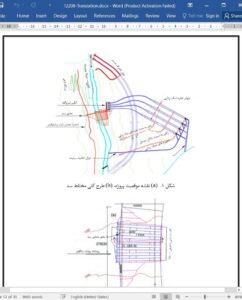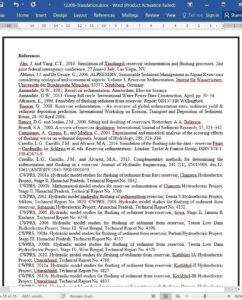ABSTRACT
The concept of sustainable development is gaining popularity and hydroelectric projects designed and operated on this concept require sediment management as prime design criteria. Drawdown flushing is being practised in such projects for sediment management. Investigations using hydraulic models are required for the projects to address the site-specific design concerns. In the present study, simulations conducted using hydraulic model for sediment removal by drawdown flushing of the reservoir of Punatsangchhu hydroelectric project, Bhutan, is presented. The experiments on 1:100 geometrically similar scale model indicated that flushing is effective in maintaining the power intake area clear of sediment deposition. Deposition from the upstream reaches could not be flushed hydraulically. Furthermore, based on wide range of experimental data from hydraulic model studies, empirical equations have been developed for predicting the quantity of sediment that can be flushed from the reservoirs. The present equations have been developed including more parameters than those used in equations already available in literature. Two equations have been developed for different riverbed slope ranges with steep slope (0.005–0.04) and moderate slope (0.001–0.005). The equations developed were validated against different sets of data and it indicated that the predictions could be made within reasonable accuracy. These equations can be effectively used for hydraulic design of sediment removal from run-of-the-river hydropower reservoirs.
1. Introduction
The storage capacity of reservoirs all over the world is reducing at the rate of 1–2% (>2% in China) per year due to sediment deposition. Studies indicate that 80% of the useful storage capacity of hydropower reservoirs will be lost by the year 2035 (Morris and Fan 1997, White 2000, Basson 2008, Schleiss et al. 2014). Since suitable dam sites for new reservoir projects are limited and/or non-existent, sustainable development of water resources projects by adopting sediment management techniques is required (Schleiss et al. 2014, Isaac and Eldho 2016). Sediment management techniques can be grouped into three categories; viz., catchment management, prevention of deposition in reservoirs and removal of already deposited sediment. Catchment management is to prevent entry of sediment into the reservoir. Sediment deposition can be prevented by bypassing sediment, density current venting and sediment sluicing. The sediment removal techniques include; drawdown flushing, dredging, dry excavation, etc. (Yoon 1992, Lai and Shen 1996, Morris and Fan 1997, Shen 1999, Brandt 2000, White 2000, Yang 2003, Annandale 2011, Schleiss et al. 2014).
6. Conclusions
In the present study, hydraulic model simulations were carried out for flushing of sediment from the reservoir of Punatsangchhu hydroelectric project in Bhutan. The 1D numerical model simulations carried out to predict the long term deposition pattern in the reservoir indicated that the sedimentation level at dam site reaches the spillway crest level in about 33 years of reservoir operation. It was also indicated that due to the typical river bed slope pattern existing along the reservoir reach, sediment deposition levels are high in the middle and upper reaches and the delta front advances to about 1.5 km from the dam axis. The experiments for hydraulic flushing was conducted on a 1:100 geometrically similar scale model of 10 km reach of reservoir with the sedimentation profile computed by 1D numerical model as initial condition. The experiments indicated that flushing is effective in maintaining the power intake area clear of sediment deposition. If flushing is carried out every year with discharges more than 800 m3 /s for 12 h, the annual sediment deposition can be flushed out. However, due to the typical flatter bed slopes in the upstream reaches, sediment deposition from the upstream reaches could not be flushed hydraulically. Alternative methods may be required to remove the deposition from the upstream reaches.











